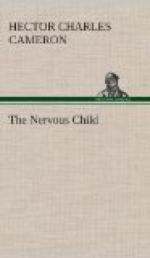Fainting fits are not uncommon amongst nervous children from about the sixth year onwards, and are apt to give rise to an unwarranted suspicion of epilepsy. In other cases fears have been aroused that the heart may be diseased. In children who faint habitually the nervous control of the circulation is deficient. We notice that when they are tired by play, or when they are suffering from the reaction that follows excitement of any sort, the face is apt to become pale, and dark lines may appear under the eyes. Yet there may be no true anaemia present: it is only that the skin is poorly supplied with blood for the moment. After a little rest in bed, or under the influence of a new excitement, the colour returns, and the tired look vanishes. If children of this type are made to stand motionless for any length of time, and if at the same time there is nothing to attract their interest or attention—a combination of circumstances which unhappily is sometimes to be found during early morning prayers at school—the want of tone in the blood vessels may leave the brain so anaemic that fainting follows. The first fainting attack is a considerable misfortune, because the fear of a recurrence is a potent cause of a repetition. Standing upright with the body at rest and the mind vacant, the circulation stagnates, the boy’s mind is attracted by the suggestion, he fears that he will faint as he has done before, and he faints. Schoolmasters are well aware that if one or two boys faint in chapel and are carried out, the trouble may grow to the proportion of a veritable epidemic. It is important that this habit of fainting should be combated not only by general means to improve the tone of the body and circulation, but also by taking care that the child understands the nature of the fainting fit, and the part which association of ideas plays in producing it. Disease of the heart seldom gives rise to fainting.




